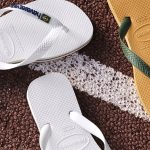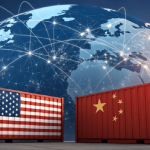By Thomas J. Ryan and Eric Smith
<span style="color: #9e9e9e;">As the new year gets underway, questions linger around the active lifestyle market. The Editors at SGB Executive compiled 20 questions, below, that are likely to dominate the headlines in 2020. The list is led by a big change at Nike and political issues from the trade war to firearms to climate change.
- How Will John Donahoe Change Nike?
On January 13, John Donahoe becomes Nike Inc.’s fourth chief executive in its five-decade history. He’ll replace Nike’s longtime CEO, Mark Parker, and is expected to lead the digital transformation of Nike. Donahoe is best known as the former CEO of eBay where his initial changes to the auction site’s fees and listings system quickly drew the ire of sellers. With digital sales vaulting 38 percent in Nike’s second quarter ended November 30, Donahoe will have to find ways to broaden Nike’s online momentum. Tougher challenges may be navigating recent workplace tensions as well as dealing with global arguments the brand often finds itself involved in as the world’s largest sportswear business. - Will The Trade War Fizzle Out?
The tariff issue dominated headlines in the active lifestyle marketplace for the last two years with more anticipated to arise in 2020—especially with the presidential race heating up. President Trump this week said the U.S. and China would sign their Phase One trade deal but many manufacturers have been adjusting their supply chains to move production out of China and into places like Vietnam. Will this latest move be enough to signal the beginning of the end of the trade war? The industry remains hopeful of a resolution. - Will Dick’s Momentum Gain Steam?
On December 2, Dick’s Sporting Goods reported its strongest quarterly same-store sales gain since 2013. Third-quarter comps grew 6 percent helped by stepped-up investments in inventory levels, the replacement of some hunt categories with higher-margin categories in team sports such as baseball as well as athletic apparel and footwear, better allocation from vendors, compelling marketing, and elevated service levels. Yet some analysts wonder how much of the improvement was due to improved stock levels rather than better execution. Continuing improvement by Dick’s in the coming quarters will further ease investor concerns that the industry has faced following the exits of Sports Authority, MC Sports, City Sports, Sports Chalet, and others in recent years. - Will There Be More Trade Show Reshuffling?
2019 was a watershed year for industry trade shows. A new outdoor hardgoods show was created (at the expense of a paddlesports-only show). Outdoor Retailer went from three shows to two. Grassroots Outdoor Alliance moved the location of its Fall Connect Show. A new running B2B event was born. The RV industry had high hopes for its new offering but it didn’t pan out. And the Snowsports Industry Association returned to the live event game by purchasing two consumer-facing shows. Click here for the full roundup. Despite all the change, there remains a concern that while trade shows might serve the purpose of bringing the industry together, they aren’t successful in helping buyers and brands get business done. - Will Competitors Emerge In Peloton’s Wake?
Peloton appears to have withstood the backlash from its advertising stumble. Now that the company is stable, what will be the impact of Peloton’s recent IPO? Will new competitors emerge in the space that Peloton created? Can Peloton itself be disrupted? The company has ambitious goals after identifying a market for stationary, connected exercise machines in the home. Other players in the space are likely to target that audience and seek their own niche while working to take share. - Will Futurelight Brighten The North Face’s Future?
The North Face regained momentum in 2019 when the company’s revenues jumped 10 percent on a currency-neutral basis in the second quarter ended September 30. But Futurelight, The North Face’s new fabric technology launched on October 1, has officials at The North Face’s parent, VF Corp., bullish for the second half of the fiscal year and beyond. Touted as the TNF’s biggest launch in years, Futurelight is promising to reset expectations that waterproof product is uncomfortable, heavy and stuffy. Extensions into more-accessible price points and other categories are expected to drive sales in the coming years. VF’s chairman, president and CEO, Steve Rendle, said on VF’s Q2 conference call, “While the financial impact of Futurelight, which is in fiscal 2020, will be somewhat limited, the disruptive innovation is casting a strong halo for the brand.” - What Will Be The Next Shot Fired In The Firearms Fracas?
Another political issue that’s sure to be affected by the 2020 presidential election, and one that will likely see more brands and retailers take a stand, is the firearms debate. Last year saw a shakeup as certain retailers (e.g., Dick’s, Walmart) step back from firearms and ammunition while others (e.g., Sportsman’s Warehouse) doubled down. On the brand side, CamelBak parent company Vista Outdoor benefited from divesting its firearms assets and landed back in REI stores. But could firearms manufacturers experience a boon if a Democratic nominee wins the White House in 2020? That was certainly the case when Hillary Clinton appeared to be on her way to a 2016 victory, but her defeat later led to the so-called “Trump Slump”—a term used to describe how the current firearms-friendly presidency quelled concerns over gun rights and stunted sales. - What’s The Next Big M&A Story?
Consolidation accelerated across the active lifestyle marketplace in 2019, so what will happen with M&A in the new year? Look for traditionally acquisitive companies like BSN, Nike and VF to make a move (VF, for example, is reportedly in the market for a new asset) and also for private equity to continue deploying capital in this space. Will smaller retailers and brands be ready if a pursuer comes calling? What do companies look for in a target? SGB Executive will be covering these topics and much more on the M&A market in the coming weeks and months. - Will There Be More Fallout In The #MeToo Movement?
The #MeToo movement was mostly quiet in 2019—but not entirely. Hundreds of Nike employees in early December marched in protest at the company’s headquarters over its treatment of women. The march took place as Nike reopened a building named after disgraced running coach Alberto Salazar, the coach of Nike’s shuttered Oregon Project. So while many companies in the active lifestyle industry addressed concerns of toxic work environments, there could be more fallout in 2020. Another issue to watch, along the same lines, is equal pay for women athletes as the Summer Olympics draws closer. - What Impact Will The Olympics Have On The Outdoor And Sporting Goods Industries?
Climbing makes its debut at the Summer Games in Tokyo this year and could be an added spark for the rapidly growing category. According to data from the Outdoor Industry Association, indoor climbers account for 52 percent of the climbing population. And the Climbing Wall Association (CWA) estimates that the indoor climbing industry will be worth $1 billion by 2021, up from $618 million in 2017. Also, the Olympics typically fuels a jump in sport participation levels like it has for gymnastics. Dynamic stars like Simone Biles could move the needle for the sport as well as anyone. - Will An Athleisure Shakeout Happen?
Lululemon, founded in 1998, is often credited with spearheading the athleisure trend and remains the dominant player in the category with 479 stores globally at the end of the third quarter. Its next direct competitor is Athleta, with 185 locations, followed by Fabletics, with 36 locations and Outdoor Voices, with 11 stores. Nike and other sports brands, luxury labels and numerous upstarts have all jumped on the bandwagon in an increasingly crowded marketplace. Yet the trend towards stretchy tops and bottoms has proved to have staying power. Market observers will be closely watching Lululemon to see if the company is able to create a bigger athleisure opportunity by reaching more males, expanding further into run and developing its own footwear range. - Will Nike’s Undifferentiated Push Rock Independents?
In 2017, Nike announced plans to narrow its focus on about 40 retail partnerships and its own direct-to-consumer efforts to ensure the brand is largely selling in premium environments. A goal was set to have 80 percent of sales reach “differentiated” selling spaces, up from only 40 percent. Since then, many Nike sellers have been wondering who makes the cut. Dick’s, Foot Locker, JD Sports, and Nordstrom have been called out as key partners. Those missing include Amazon as Nike, in November, announced it would stop selling directly to Amazon after a test. In the U.K., Sports Direct, in October, called for a European-wide investigation into the dominance of Nike and Adidas in the sportswear market after facing challenges securing Nike product. Reports also arrived last year that a number of independent shops in the U.K. were notified that they would no longer have access to Nike products by 2021 and similar notifications are expected to reach numerous independents in the U.S. - Will DTC Push Gain More Momentum?
DTC, driven by digital, is expected to continue to be the fastest-growth driver for many brands. For brands, director-to-consumer (DTC) has many advantages including often-higher margins than selling wholesale and being able to offer extensive collections to tell a fuller brand story. DTC also enables brands to directly engage with consumers. Online, rewards programs and innovative apps have upped those connections with consumers to another level. Mark Parker, Nike’s president and CEO, said on Nike’s recent quarterly call, “Membership sits at the heart of that strategy giving consumers a more personal relationship with Nike.” - How Will Experiential Retailing Surprise?
The experiential retailing trend should offer more experimentation in 2020. In 2019, Lululemon opened its most experiential store to date, a two-level, 20,000-square-foot plus location in Chicago’s Lincoln Park neighborhood. The store features Lululemon’s first restaurant and meditation studio, yoga studio, and high-intensity workout studio. In an unusual twist, customers can wear select Lululemon products to try during a studio workout before committing to buying an unworn version. Nike continues to open new stores that bridge the gap between digital and physical. The brand’s Nike Live stores, for example, feature a NikePlus Unlock Box digital vending machine that acts as a focal point of the store and also allows customers to redeem products using their Nike App member passes. - What Will Amazon Do Next?
In April, Amazon announced that it would invest $800 million to cut the time it takes to make deliveries to Prime members from two days to one. The e-tail giant also continued its aggressive moves in 2019 to build its own delivery network to compete with UPS and Fed-Ex, expand its private-label offerings and experiment with a number of physical retail concepts. Amazon, which controls about half of the online purchases in the U.S., will continue to offer more surprises in 2020. Market observers will also be looking at how Amazon counters Nike’s decision to stop selling directly to Amazon as well as how it addresses charges over poor workplace conditions and its environmental debt. - What’s The Future Of Department Stores?
Department stores headed into Black Friday and the holiday season with a little bit of momentum, as most stores saw decent third quarters and all four in our most recent roundup—Nordstrom, J.C. Penney, Dillard’s and Macy’s—beat Wall Street earnings per share estimates. But issues remain as shoppers continue to migrate online. Also, stores like J.C. Penney are still a bankruptcy risk and other traditional retailers like Stage Stores convert to an off-price format. SGB Executive will continue to track these stores and other retailers such as Macy’s, Nordstrom, Kohls, and Dillard’s in 2020. - Will JD Sports Gain A Warm Welcome In The U.S.?
This spring, JD Sports will open a flagship store in Times Square. Since acquiring the Finish Line in July 2018, the U.K.-based chain has quietly opened 11 JD Sports locations in the U.S. in former Finish Line locations. The concept is more fashion-forward and carries more apparel in its mix than Finish Line as well as its global rival Foot Locker. Market observers will also be watching how much of JD Sports’ DNA finds its way into the more than 500 Finish Line stores and over 300 Finish Line in-store shops inside Macy’s. - Will Off-Pricers Hot Streak Continue?
Off-price retailers like T.J. Maxx, Marshall’s, Ross, and Burlington are seen as one of the few retail winners of the U.S. and China trade war because their retail model thrives on supply-chain disruption. The long challenges faced by department stores have also helped a surplus of excess goods to find their way to off-price racks. The decline of department stores, a robust economy and the pressure to sell online may bring new challenges for the off-price sector in 2020. - How Will Retailers And Brands Address Climate Change?
With the presidential campaign gaining speed and climate change center stage, look for outdoor and sporting goods retailers and brands to amplify their pro-climate action messages in 2020. Another global climate strike could bring more players into the fold while many more could become B Corp companies or 1% For the Planet members. - What C-suite Changes Will We See?
Last year many companies saw succession plans kick including Nike Inc., Under Armour and Hibbett Sports (click here for the full list). Companies are more than their leaders, of course, but the departure of a popular or polarizing CEO can have a significant impact on a company’s brand. SGB Executive will continue to report on who lands where in 2020 and expect some surprising appointments in the year to come.
















